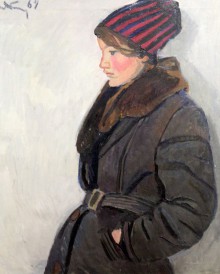The exhibit “Great Expectations” is underway at the gallery Khlibnia, Sophia of Kyiv Preserve. It showcases the samples of Ukrainian pictorial art of the 1960s (to be more precise, late 1950s – early 1970s).
The difference of the exposition from the prevailing interpretation of the 1960s is felt already at the stairs under the exhibition halls, where the advertisement placards of that time have been placed. The first hall is dedicated to placards and caricatures. However, it doesn’t plunge deeply into ideology. But the line of mild and vivid positive can be traced everywhere. The exhibit “Great Expectations” shows the 1960s not as a resistance, alternative struggle, and underground, but rather as a thaw in direct meaning of this word: things were getting easier and more vivid, there was a gulp of fresh air. Simple and often routine hopes for the best. The attempts to renew something or come back to closed and forgotten things.
Clearly, to some extent most of the artists, though not all of them, return to the traditions of Ukrainian and foreign Modernism and Avant-garde. These stylistic trends at the new stage of the artists whose works are on display at the “Great Expectations” exhibit turned out to be, of course, far not so experimental and conceptual, like, for example, in the 1920s. They became cozier and more lyrical – a kind of neoclassic. They existed in interesting versatile ways with the realistic-romantic tradition. Of course, this is also a return to the motifs of the national art. Again, it is quite moderate. After all, it is hard to imagine the art of the Soviet Ukraine of the 1960s without a refusal from the rule of Socialist Realism of the previous decades (it would be a great exaggeration to say that it disappeared completely by that time).
Light airy landscapes, contemplative portraits, porcelain statuettes of jazz musicians, genre scenes on beaches, skating-rinks, and markets, the architecture projects of Kyiv subway stations and many districts of Kyiv, which in these pictures seem elegant and stylish, not the way they are looking now. The 1960s of high hairdos and quiet courtyards of future megalopolises, and not the 1960s of dissident movement. In this sense, the exhibit “Great Expectations” enters an interesting dialog with another exhibit “The Art of Ukrainian Sixtiers. A Possibility of a Museum,” which is being held simultaneously at the National Museum of Art of Ukraine. For the exhibit at the National Museum is oriented at more monumental and conceptually more consistent wing of the then Ukrainian art with the expressive spirit of, if not a political protest, then at least a challenge and gesture. Of course, it is best to see both of these exhibits, in order to get a maximum stereoscopic effect.
What is gratifying in “Great Expectations” is the lightness of the exposition. Starting in quite a playful and accentuated way (there is a remarkable placard that calls one to go to work in the Donbas, it was illustrated by a Hutsul in a train to Stalino), later it leaves the visitor face-to-face with art. Paradoxically, the condition of these works, which are often worn out (they were gathered from various public and private collections), only increases the feeling of intimacy. And the feeling of historicism, too, a kind of an antiquary effect.








